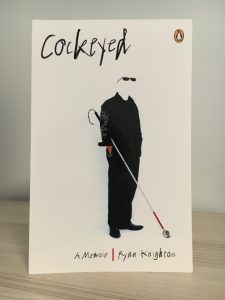A Peritextual Analysis
Ryan Knighton’s Cockeyed, exemplifies the feeling of both absence and hope through his minimalistic book cover. Upon first glance, the most noticeable aspect of this cover is in fact how little imagery dominates the front. Set on stark white background, the attention of the reader is drawn to the key aspects of this cover – the title, the name, and the one subject, a man holding a white cane. This minimalistic approach allows for closer examination of the each of these aspects.

As Thomas G. Couser examines another disability memoir, Ruth Siekiewicz-Mercer’s, I Raise My Eyes to Say Yes, he notes this form of “self creation:… crucial to [the] physical and psychological emancipation”. Likewise, the cover is a further extension of this creation of self, and the fundamental ideas of self-representation within the novel. The image seems to emulate an image society is used to receiving of a blind man. When you look at his face, however, you realize that there are no borders, or outline, that frames it. It blends seemingly into the background, giving the sense of a lost inner self, while the outside, his body, remains in tact. He remains just a blind man, with a cane that acts as his eyeball. The embodiment of this lost self is intriguing as it makes you wonder its deliberate use and its connection to the memoir.
Furthermore, the choice of font for both the book title, as well as the author’s name is unkempt. It seems to be written by hand, with each letter unique to itself, rather than a computer made digitalized font. The cover depicts the very basis of what the book is about, a memoir, who wrote it, Ryan Knighton. In doing so, the typeface establishes the connection with the reader that Knighton composes this book himself with raw details and emotions, sentiments often associated with penmanship.
Although this memoir depicts the life of a blind man, a disability society has grown to pity, the choice of the colour white allows it to seems hopeful and light, as opposed to dark and grave. This light view is further supported by Don McKellar’s review on the back, commenting on Knighton “[screwing] up [his] job” and “[crashing his] Dad’s car”, all incidents the public can relate to humorously. McKellar also gives insight to Knighton’s strained love life, and coupled with Knighton’s dedication “for [his] gal” on the inside, provokes society’s empathy for a romantic love story, and increasing both interest and sales. (TheRichest). Together, these aspects lead readers to assume that this memoir is a “triumph rhetoric” (Couser). In other words, it plays on society’s love for “triumph over adversity” (Couser, 33) by signaling the happiness the disabled will inevitably experience, and in turn, evoke the same emotion from the readers.
As a consumer, the exterior of this book is not only visually stimulating, but also emotionally. The synopsis describes Knighton as a “wicked, smart, blind guide at the wheel” inviting the public on a journey that differs from the norm of an incapable handicap. Ryan Knighton’s memoir, Cockeyed, physically embodies the sense of lost identity and hope, spurring readers to further investigate correlation between the two, wondering about the obstacles the author faces, and ultimately reading to the end in hopes for the “inspirational…and generalizable” (Couser, 33) outcome.
Works Referenced
Knighton, Ryan “Cockeyed” Penguin Group: Toronto, 2006. Print.
Couser, G Thomas “Signifying Bodies: Disability in Contemporary Life Writing” University of Michigan Press, 2009. Print. pp. 31-48
Stewart, Thomas. “Which 5 Book Genres Make The Most Money?”. TheRichest. N.p., 2014. Web. 7 Oct. 2016.
